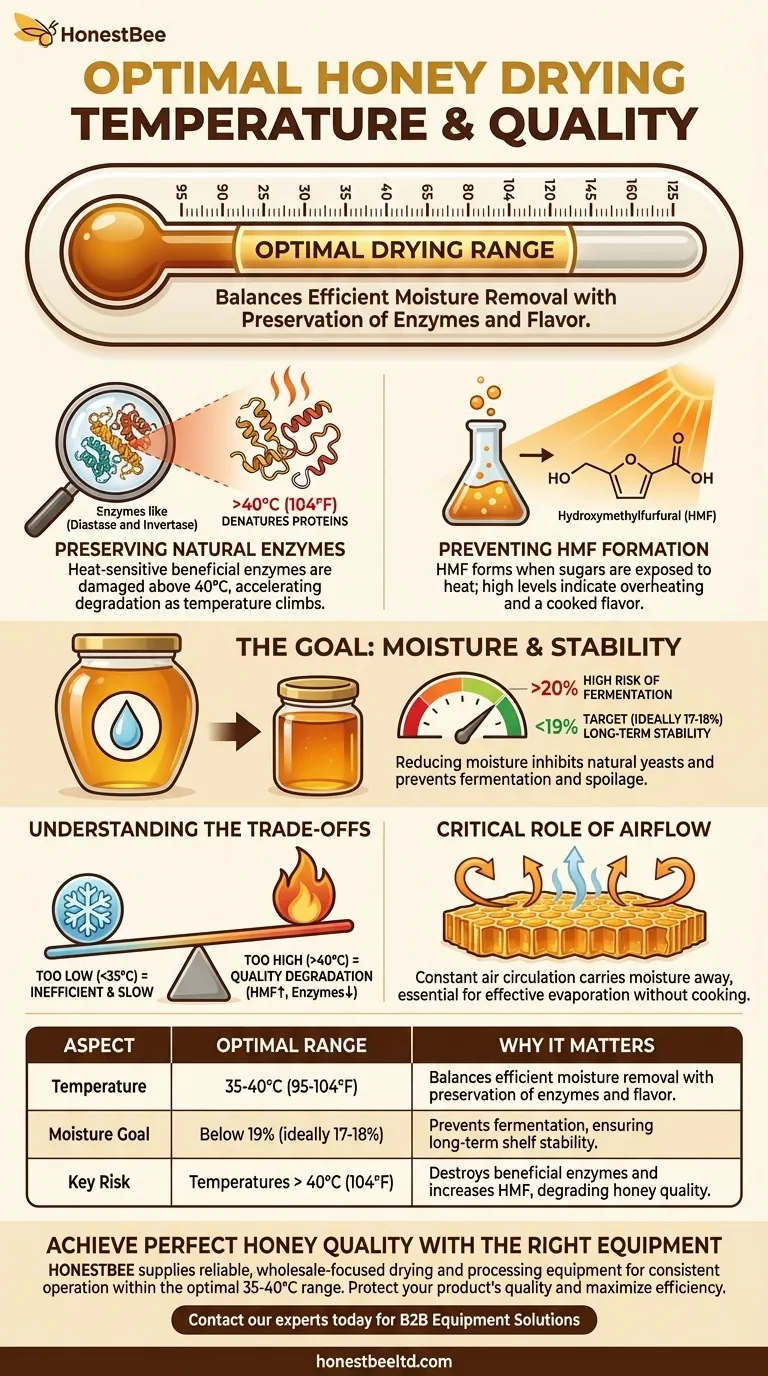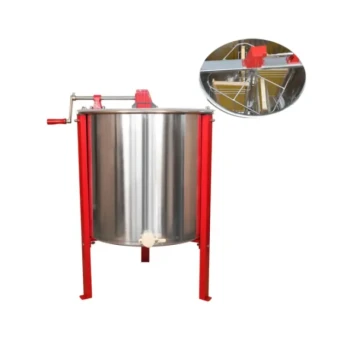The optimal temperature range for drying honey is between 35-40°C (95-104°F). This specific range is critical because it effectively lowers the honey's moisture content to prevent fermentation while being low enough to protect its delicate, heat-sensitive enzymes and beneficial compounds. Exceeding this temperature, even slightly, begins to degrade the very qualities that define high-value, raw honey.
The core challenge in preparing honey is balancing the need for long-term stability with the preservation of its natural quality. The 35-40°C range represents the ideal balance, allowing for efficient moisture removal without initiating heat damage that compromises enzymes and flavor.

Why Temperature Control is Critical for Honey Quality
The temperature used to process honey is arguably the single most important factor in determining its final quality. Honey is not just a sugar solution; it is a complex biological substance, and heat is its primary adversary.
Preserving Natural Enzymes
Honey contains beneficial enzymes, such as diastase and invertase, which are introduced by the bees during its creation. These enzymes are key indicators of raw, unprocessed honey.
However, they are extremely sensitive to heat. Temperatures above 40°C (104°F) begin to denature these proteins, and the damage accelerates rapidly as temperatures climb toward 50°C (122°F).
Preventing HMF Formation
Hydroxymethylfurfural (HMF) is a compound formed when sugars, particularly fructose, are exposed to heat. Its presence in significant amounts is a clear chemical indicator that the honey has been overheated.
Keeping the drying temperature below 40°C minimizes the formation of HMF, ensuring the honey maintains its "raw" status and does not acquire a cooked or caramelized flavor profile.
Maintaining Ideal Consistency
Excessive heat alters honey's physical properties. Heating beyond the recommended range can cause it to become overly tacky and can negatively affect its texture and digestibility.
The Goal of Drying: Moisture and Stability
The entire purpose of drying honey is to ensure it remains stable and does not ferment in storage. This is achieved by reducing the water content to a level that inhibits the growth of naturally occurring yeasts.
The Problem of High Moisture
Honey with a moisture content above 20% is at high risk of fermentation. This process spoils the honey, creating alcohol and sour off-flavors.
The Target for Preservation
The goal is to reduce the moisture level to below 19%, and often as low as 17-18%, for ideal long-term stability. This makes the honey shelf-stable for years.
How Low Temperatures Work
Even at the relatively gentle temperature of 35°C (95°F), warm, circulating air creates an environment where water can effectively evaporate from the honey's surface without "cooking" the product itself.
Understanding the Trade-offs
Choosing the right temperature is a matter of balancing efficiency with quality preservation. While the 35-40°C range is ideal, it's important to understand the consequences of deviating from it.
The Risk of Going Too High
This is the most significant danger. Exceeding 40°C directly compromises the honey's quality by destroying enzymes and increasing HMF. The higher the temperature, the faster the degradation occurs.
The Inefficiency of Going Too Low
Drying honey below 35°C is certainly safe for its quality, but it is also much slower. The reduced temperature significantly lengthens the time required to achieve the target moisture content, making the process less efficient.
The Critical Role of Airflow
Temperature alone is not enough. Effective drying relies on constant air circulation to carry moisture away from the honey's surface. Without good airflow, a pocket of humid air can form, stalling the evaporation process regardless of the temperature.
Making the Right Choice for Your Goal
Your specific objective should guide your approach to the drying process.
- If your primary focus is preserving raw honey quality: Strictly adhere to the 35-40°C (95-104°F) range and use a reliable honey hydrometer to monitor moisture levels.
- If your primary focus is process efficiency: Operate at the higher end of the safe range (around 40°C) and ensure your drying equipment provides strong, consistent air circulation to speed up evaporation.
- If you are concerned about quality validation: Consider testing for HMF levels after processing to scientifically confirm that your method has not subjected the honey to excessive heat.
By carefully managing temperature and airflow, you can guarantee a stable honey that retains all of its natural, high-value characteristics.
Summary Table:
| Aspect | Optimal Range | Why It Matters |
|---|---|---|
| Temperature | 35-40°C (95-104°F) | Balances efficient moisture removal with preservation of enzymes and flavor. |
| Moisture Goal | Below 19% (ideally 17-18%) | Prevents fermentation, ensuring long-term shelf stability. |
| Key Risk | Temperatures > 40°C (104°F) | Destroys beneficial enzymes and increases HMF, degrading honey quality. |
Achieve Perfect Honey Quality with the Right Equipment
Ensuring your honey retains its raw, high-value characteristics requires precise temperature control and efficient airflow. HONESTBEE supplies commercial apiaries and beekeeping equipment distributors with the reliable, wholesale-focused drying and processing equipment needed to consistently operate within the optimal 35-40°C range.
Let us help you protect your product's quality and maximize your operational efficiency. Contact our experts today to discuss the best equipment solutions for your apiary.
Visual Guide

Related Products
- High Quality Honey Dehumidifier Dryer Thickening Machine for Beekeeping
- Stainless Steel Manual Honey Press with Guard for Pressing Honey and Wax
- Honey Concentrating and Filtering Dehumidifier Machine 2T Capacity for Honey
- Stainless Steel Manual 8 Frame Radial Honey Extractor Machine for Beehives
- HONESTBEE 4 Frame Manual Self Reversing Honey Extractor for Beekeeping
People Also Ask
- How to remove humidity from honey? Protect Your Harvest from Fermentation
- Can you dehumidify honey? A Beekeeper's Guide to Preventing Fermentation
- How does a honey dryer remove moisture from honey? Achieve Perfect Honey Stability with Controlled Drying
- How to reduce moisture level in honey? Preserve Quality and Prevent Fermentation
- What are some dehumidification techniques for reducing honey moisture? Preserve Quality & Prevent Fermentation



















